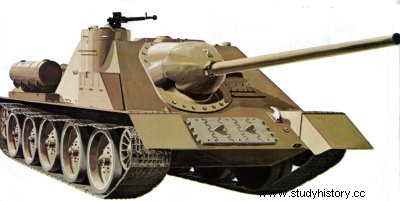
SU- 1 00
Country USSR
Type:medium self-propelled gun.
Crew:4 men.
Armament:one 100mm Model 1944 cannon (D-IOS);
2 7.62mm PPS machine guns.
Shielding:minimum 20 mm;
maximum 54 mm.
Dimensions:
length (barrel included):9.45m;
width:3m;
height 2.25 m.
Weight in combat order:31.6t.
Ground pressure:0.82 kg/cm2.
Mass power:16 hp/t.
Engine:Model V-2-34 12 cyl. water-cooled diesel,
developing 507 hp at 1,800 rpm.
Performance:
road speed:48 km/h;
autonomy:320 km;
vertical obstacle:064 m
straight cut:3 m;
slope:300.
Service time:introduced in the Red Army in 1944 and still used today by the armies of many countries, including Albania, Algeria, East Germany, Bulgaria, the People's Republic of China, Korea North, Cuba, Egypt, Iraq, Morocco, Mongolia, Romania. Syria, Czechoslovakia, the Soviet Union, North Yemen and Yugoslavia.
When the T-34 medium tank was fitted with the 85 mm gun, becoming the T-34/85, it became necessary to increase the firepower of the medium self-propelled gun that used this chassis. As the SU-85 could no longer play its role effectively as a medium tank support vehicle, the Soviets began in 1944 to replace it with the new, more powerful SU-100 self-propelled gun. This one was very similar to its predecessor, but it was armed with the new 100 mm Model 1944 (D-I0S) gun, designed by the team of General F.F. Petrov. Production of the SU-100 began in Uralmashzavod in September 1944, and by the end of the year about 500 units had been delivered to the army. By the end of the war, more than 1,800 had been built. The SU-100 proved to be very effective in destroying German heavy tanks and tank destroyers, such as the Panther, Tiger, Ferdinand, Jagdpanther and Jagdtiger. He played a very important role during the final stages of World War II.
The 100 mm gun, which armed this vehicle, was an adaptation of the pre-war rapid-fire, dual-purpose 100/56 naval gun. As on the SU-85, the gun was mounted at the front of a steeply sloped fixed armored superstructure and the aiming was done using a tank gun periscope. Unlike that of the T-34 tank, on which the SU-100 was based, the driver of the latter was separated from the other crew members by armor plates, which required the presence of
an internal communications system. Like the SU-85, the SU-100 had no auxiliary armament.
Much more effective than the 85mm gun, the 100mm gun fired a 16kg high shell. at a distance of 19,200 m, or a 19.5 kg armor-piercing shell. Ammunition load was 34 shells. The SU-100 differed from its predecessor not only by its significantly longer gun but also by the new shape of its mantlet and by its circular cupola fixed at the top of the superstructure, on the right.
The SU-100 remained the standard support gun for the armored and motorized divisions until their reorganization in 1957. It was then replaced by the ISU-122, based on the IS heavy tank chassis. After the war, disarmed SU-85s and SU-100s were used for a long time as armored command or recovery vehicles. In such cases, the embrasure of the removed gun was sealed with armor plate.
